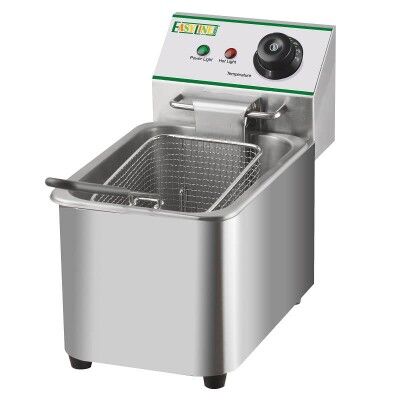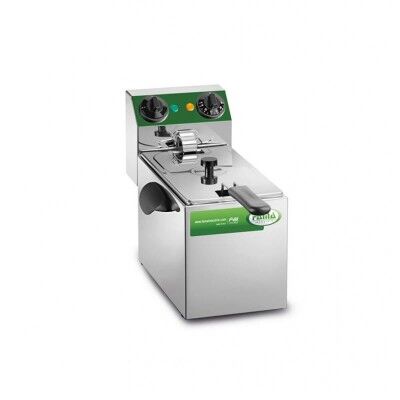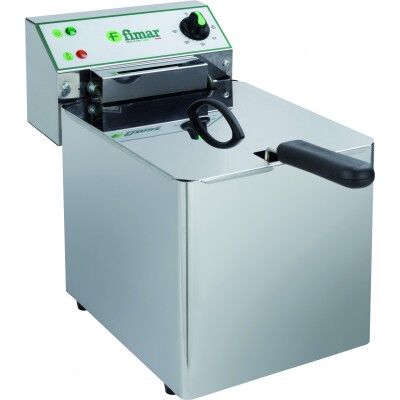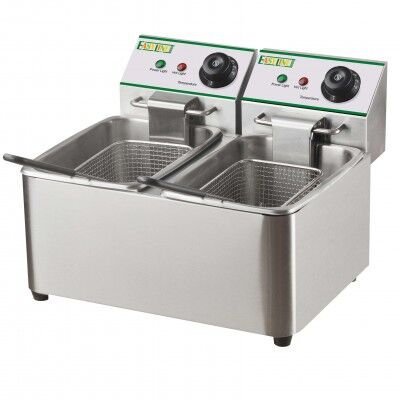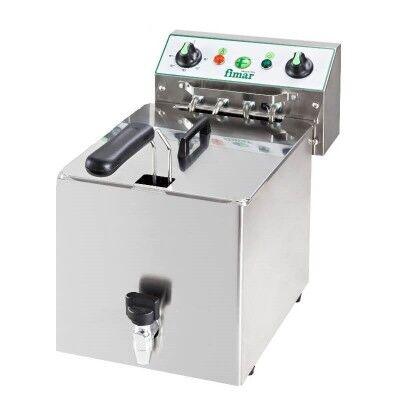Professional Fryers
In this section, you will find a wide range of products related to the world of professional fryers.
All fryers in this catalog are made with a stainless steel frame, including both countertop fryers and floor-standing (cabinet) models. There are many professional fryers available, with variations ranging from the type of power supply: single-phase or three-phase, to the type of tank: single or double, as well as the capacity in liters, and versions with an integrated drain valve for easy management of frying oil. Additionally, on various types of electric fryers, you can choose your preferred configuration. If you have any doubts, feel free to contact us, and one of our consultants will be available to help you choose the best quality-price ratio.
Professional Fryer
Differences Between Professional and Domestic Fryers:
A professional fryer is designed for intensive and continuous use, which is why it differs from domestic fryers in several ways.
Firstly, professional fryers typically have a larger tank capacity compared to domestic fryers, allowing for the cooking of a larger quantity of food in a single cycle. Moreover, professional fryers are designed to be faster, more efficient, and more durable, making them perfect for professional use.
Additionally, professional fryers are equipped with functions and features that distinguish them from domestic fryers. For example, fryers for food service are equipped with safety micro-switches, such as the automatic ignition lock, which prevents the heating elements from turning on if the machine components are not properly positioned, and also feature a pilot flame and a piezoelectric ignition system.
Key Features of a Fryer
When choosing the right professional fryer for your needs, it is important to consider the most important features a good fryer should have.
First of all, the professional fryer should be equipped with a rapid heating system that allows it to reach the desired temperature quickly for cooking food. It should also have an adjustable thermostat, allowing precise temperature setting and maintaining a constant temperature during cooking.
Furthermore, the professional fryer should have a safety system that prevents oil overheating and reduces the risk of fire. Some professional fryers are equipped with an automatic shut-off system that activates in case of overheating.
Finally, the professional fryer should be built with an AISI304 stainless steel frame to ensure durability over time and effective resistance to wear and corrosion.
How to Choose a Professional Fryer
To choose the right professional fryer for your needs, it is important to consider several key factors.
Firstly, you need to consider the capacity of the professional fryer, that is, the amount of food it can hold. Based on your needs, you can choose a fryer with a capacity ranging from 4 to 25 liters.
Additionally, for electric versions, it is important to evaluate the absorbed power, which is the amount of energy used to heat the oil. In general, a professional fryer should provide power sufficient for efficient and fast cooking. The power of an electric professional model typically ranges from 2.5 kW for smaller models, up to 33 kW for double-tank versions of 24 liters, ensuring the ability to reach 190°C within a few minutes of turning on.
Top-of-the-line gas fryers should be equipped with stainless steel tubular burners with a "Turbulator" system that slows down the flame flow, increasing its efficiency by about 50%.
Finally, it is important to evaluate the ease of use of the professional fryer. For example, some fryers are equipped with a digital temperature control system that allows you to set the desired temperature simply and precisely.
For gas versions, combustion safety must be guaranteed by law through a thermocouple valve and a safety thermostat.
How to Clean a Professional Fryer:
Cleaning and maintaining professional fryers is essential to ensure proper functioning and longevity.
First, it is important to regularly clean the holding tank and heating elements, removing any food residues and changing the oil after a certain number of uses. To facilitate cleaning, many professional fryers are equipped with an oil draining system that allows easy and quick emptying of the tank through a convenient drain valve.
Additionally, it is advisable to clean the exterior structure of the fryer regularly, using specific, non-abrasive cleaning products. It is also recommended to remove detachable parts of the fryer (such as baskets or oil collection trays) and wash them separately.
Finally, it is essential to carry out maintenance on the professional fryer according to the manufacturer's instructions. Following these instructions is important to ensure the fryer continues to function properly over time and avoids any tampering or improper use that could lead to the voiding of the warranty.
Type of Oil for Frying
Below are some useful details to understand the frying process and the best oil choices for this type of cooking. First, it is important to consider that frying is a process that challenges the stability of the oil, as it can cause the formation of harmful substances due to oxidation at high temperatures.
When choosing the best oil for frying, it is important to consider the content of monounsaturated fatty acids. Olive oil, for example, has the highest amount of oleic acid, which makes it more resistant to high temperatures than other oils. Peanut oil is also ideal for frying due to its high resistance.
Extra virgin olive oil, due to being unrefined, is not recommended for frying because of its higher content of free fatty acids that can degrade at high temperatures. Additionally, sunflower, corn, and soybean oils tend to deteriorate easily when exposed to air and high temperatures.
For good frying, it is important to fry foods at the correct temperature, which should be between 160°C and 180°C. It is also essential to use an adequate amount of oil and fry foods in batches so that the oil temperature remains constant and even.
Finally, it is advisable to avoid reusing frying oil and instead replace it with fresh oil rather than topping it off.
In summary, the guidelines for choosing the best oil for frying primarily concern the ideal temperature for frying food, the amount of oil to use, and the characteristics of various oils mentioned above. Following these simple guidelines can help ensure even cooking of food and prevent the formation of harmful substances during the frying process.


